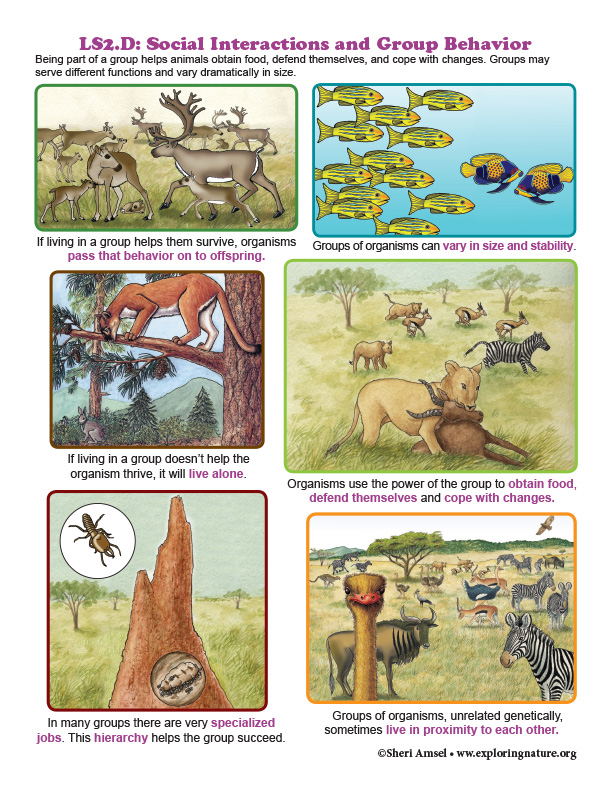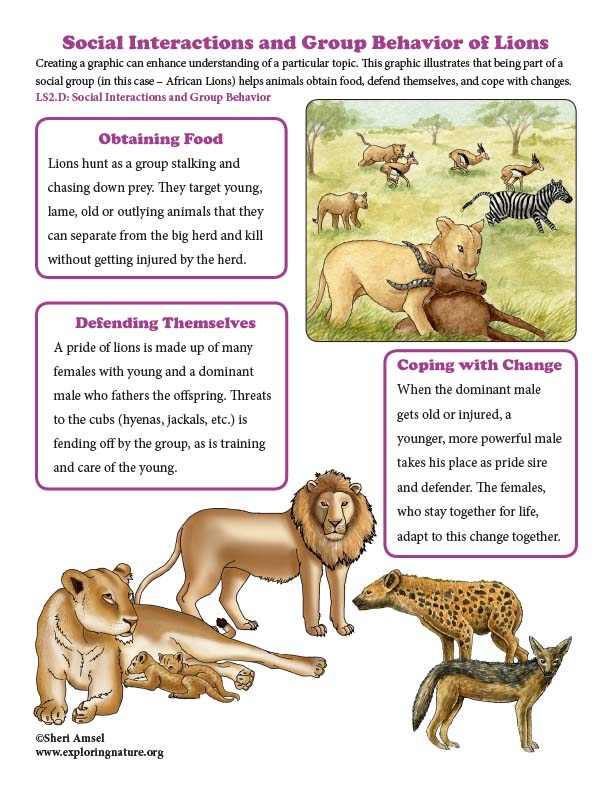

_________________________________________________________________________________________________________________________________________________________
Disciplinary Core Ideas
LS2.D: Social Interactions and Group Behavior
• Being part of a group helps animals obtain food, defend themselves, and cope with changes. Groups may serve different functions and vary dramatically in size (Note: Moved from K–2). (3-LS2-1)
Performance Expectations Students who demonstrate understanding can:
3-LS2-1. Construct an argument that some animals form groups that help members survive.
_________________________________________________________________________________________________________________________________________________________
Use the Template and Resource Links to Fulfill NGSS
l. Goals:
Essential Questions:
ll. Introductory Activities to Assess Prior Knowledge
A. Simple Activities - that assess students’ understanding of social interactions and group behaviors.
Animal Group Matching
Animal Group Behavior - Matching Activity
Social Interactions and Group Behavior Short Answer Quiz
Social Group or Solitary? Matching and Critical Thinking Quiz
B. Brainstorming Session
Question: Which animals live in a group and how does it help them survive?
1. Break students down into groups of 3-4.
2. Ask students to generate a list of up to 5 animals that they know of that live in groups and how this might help them survivie.
3. Discuss
lll. New Knowledge - Text
A. Read about animals that live in groups and consider how this helps them.
Social Interactions and Group Behavior Reading
Social Interactions and Group Behavior - Diagram
Mammals that live in groups: Baboons, Bison, Caribou, Chimps, Deer, Dolphins, Elephants, Elk, Hippos, Kangaroos, Killer Whales, Lions, Llamas, Mountain Goats, Vincuna, Water Buffalo, Wildebeest, Wolf, Yaks, Zebras
Birds that live in large flocks: Flamingos, Geese, Goldfinches, Red-winged Blackbirds, Penguins, Pigeons, Quail, Starling, Waxwings, Wild Turkeys
Insecsts that live in groups: Honeybee, Termites
B. Read about how living in a group can help drive adaptations that increase survival. Use critical thinking to connect the group dynamic to their survival.
Adaptation Illustrated
lV. Experiments, Activities, Model-making (Critical Thinking)
Inquiry related to social interactions and group behaviors. Choose and Research an animal that lives in a group and then use critical thinking to complete the social interactions and group behavior sheet below about them:
Group Behavior Research Project - Critical Thinking
Social Interactions and Group Behavior Graphic Organizer
Social Interactions and Group Behavior Poster
Caribou and Wolves - Social Interactions - Critical Thinking Activity
Social Interactions and Group Behavior Short Answer Quiz
Social Group or Solitary? Matching and Critical Thinking Quiz
Assessment: Social Interactions and Group Behavior - Multiple Choice Test
V. Summarize Knowledge - Enduring Understandings
LS2.D: Social Interactions and Group Behavior
• Being part of a group helps animals obtain food, defend themselves, and cope with changes. Groups may serve different functions and vary dramatically in size (Note: Moved from K–2). (3-LS2-1)
Science and Engineering Practices (NGSS)
Engaging in Argument from Evidence
Engaging in argument from evidence in 3–5 builds on K–2 experiences and progresses to critiquing the scientific explanations or solutions proposed by peers by citing relevant evidence about the natural and designed world(s).
• Construct an argument with evidence, data, and/or a model. (3-LS2-1)
Crosscutting Concepts
Cause and Effect
• Cause and effect relationships are routinely identified and used to explain change. (3-LS2-1)
Performance Expectations
Students who demonstrate understanding can:
3-LS2-1. Construct an argument that some animals form groups that help members survive.
Common Core State Standards Connections
ELA/Literacy
RI.3.1 Ask and answer questions to demonstrate understanding of a text, referring explicitly to the text as the basis for the answers. (3-LS2-1)
RI.3.3 Describe the relationship between a series of historical events, scientific ideas or concepts, or steps in technical procedures in a text, using language that pertains to time, sequence, and cause/effect. (3-LS2-1)
W.3.1 Write opinion pieces on topics or texts, supporting a point of view with reasons. (3-LS2-1)
Mathematics
MP.4 Model with mathematics. (3-LS2-1)
3.NBT Number and Operations in Base Ten. (3-LS2-1)
Articulation of DCIs across grade-levels:
1.LS1.B (3-LS2-1); MS.LS2.A (3-LS2-1)
When you research information you must cite the reference. Citing for websites is different from citing from books, magazines and periodicals. The style of citing shown here is from the MLA Style Citations (Modern Language Association).
When citing a WEBSITE the general format is as follows.
Author Last Name, First Name(s). "Title: Subtitle of Part of Web Page, if appropriate." Title: Subtitle: Section of Page if appropriate. Sponsoring/Publishing Agency, If Given. Additional significant descriptive information. Date of Electronic Publication or other Date, such as Last Updated. Day Month Year of access < URL >.
Amsel, Sheri. "Grade 3 - 3-LS2 Ecosystems: Interactions, Energy, and Dynamics" Exploring Nature Educational Resource ©2005-2024. December 15, 2024
< http://www.exploringnature.org/db/view/Grade-3-3-LS2-Ecosystems-Interactions-Energy-and-Dynamics >



